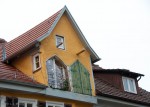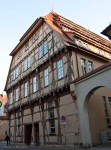We live in the Altstadt (literally, “old city”) part of Tübingen. Our building dates to 1513, although it was remodelled last year just before we moved in.
I call our building one of the “rock stars” of the neighborhood; on most days, there are people stopped outside, either looking it over, or peeking in to see what it’s like inside. It’s almost like being famous ourselves, although it’s the building that people are interested in, not the residents, of course.
This whole part of town is filled with medieval-era houses like ours, most of which have been renovated to one extent or another as part of an urban renewal effort by the mayor 20 years ago to revitalize the Altstadt. His program seems to have worked, as it’s a thriving area today, filled with little shops, cafes, and artisan galleries. For example, there’s a pottery gallery around the corner from our building, and a man who makes violins and other stringed instruments down the block. Many of the buildings, like ours, have retained the “half-timber” style of construction outside, so you see the beams mixed in with the plaster, while some of the buildings have been redone and completely stuccoed over. I don’t know enough about the different styles to know which one was more common originally. But certainly the quaint style that I associate with German architecture like this is with the beams showing.
As we were walking around our neighborhood the other day, we noticed that the buildings don’t all come from the same period. I tend to think of the “Middle Ages” as a single moment in time, but of course it spanned several hundred years. So, while our building is from the early 1500s, one of the Tübingen city halls, the Bürgeramt, which sits at the end of our block, was built in the late 1400s. It was redone and turned into the city hall about 10 years ago.
Going down the street in the other direction from our apartment, you run into a set of houses that are relative newcomers in this area, since they were built in the 1700s. A lot of these buildings are just stucco on the front now, although a few do still show the half-timber style architecture.
Sitting in between those areas is the oldest surviving section of the Altsttadt, where you can find the oldest building in Tübingen, which was built in 1323. That’s nearly 200 years before our house was built. It, like all the rest, have been refurbished in the last decade or so, but still, you start to get a glimpse of what the buildings might have looked like in the Middle Ages. Well, as long as you can tune out the antennas and satellite dishes, of course, when you look at them.
Here are some photos of a few of the buildings in our neighborhood; keep in mind that all have been renovated in the last 20 years or so:
- “Modern” building from 1700s
- Half-timber style next to building that’s been renovated with all stucco
- Oldest house in Tübingen, built in 1323
- Down the street from the Burgeramt
- Burgeramt Detail showing the renovated timber
- Burgeramt, built in late 15th century, and beautifully renovated in the early 21st century
- Our apartment building, built in 1513, rennovated in 2011
It’s fun to walk around and realize that our neighborhood has evolved over hundreds of years, and in some ways is still evolving thanks to all the refurbished places.
My favorite factoid, though, was realizing the name of the street where the oldest building is located: it’s on Neustadt strasse, “New City Street”.
Everything old was new at some point, I guess.
*****
Since I’ve had a Peter Allen song running through my mind ever since I came up with the name for this blog post, here’s a link to Peter Allen singing it: Everything Old is New Again.








Love those pictures of the houses beautiful
Thanks, Kathy